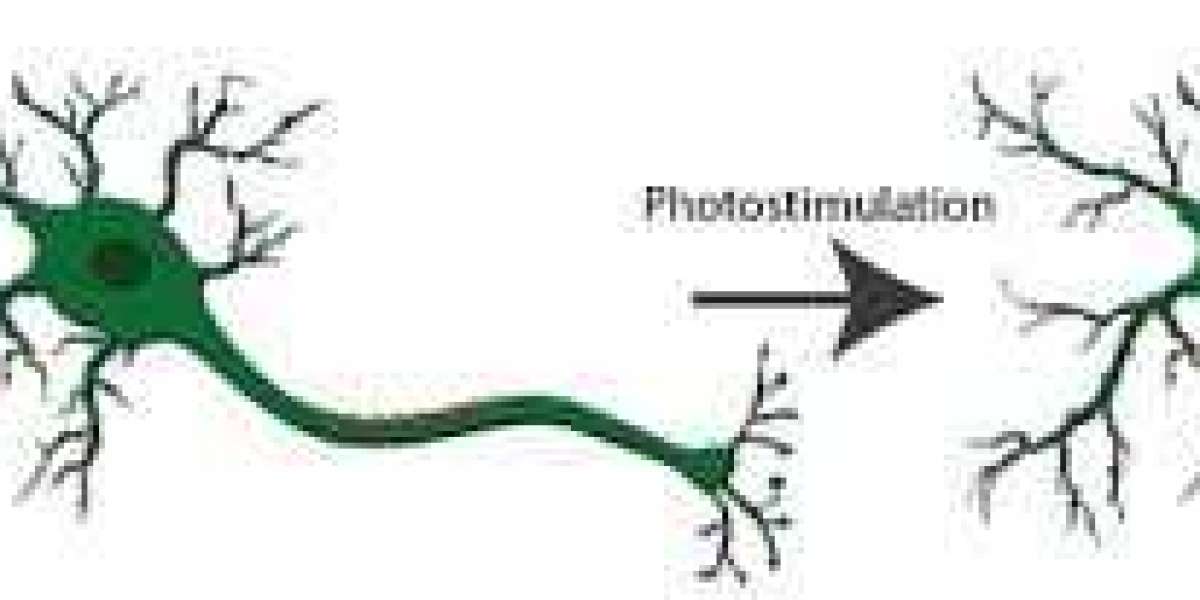Optogenetics is a revolutionary technique in neuroscience that combines genetics and optics to control the activity of specific neurons in living organisms. Through this technique, scientists can manipulate neural circuits with unprecedented precision using light, leading to groundbreaking discoveries in brain function, behavior, and treatment for various neurological and psychiatric disorders. By using light-sensitive proteins called opsins,optogenetics allows researchers to investigate the brain’s intricate workings at an unparalleled level of detail.
This article explores the core principles of optogenetics, its historical development, how it works, its applications in neuroscience, the challenges it faces, and the potential future of this powerful tool.
What is Optogenetics?
Optogenetics is a method that allows scientists to control the activity of specific neurons or groups of neurons using light. This is achieved by introducing light-sensitive proteins, called opsins, into the neurons of interest. These opsins are typically derived from microorganisms such as algae or bacteria, where they function to detect and respond to light. When these opsins are expressed in neurons, light can be used to either activate or inhibit these neurons, depending on the type of opsin used.
The two main types of opsins used in neuroscience are:
Channelrhodopsins (ChRs): These proteins are activated by blue light and cause the neuron to depolarize (excite). This leads to the neuron firing and transmitting signals.
Halorhodopsins (HRs): These are activated by yellow or green light and cause the neuron to hyperpolarize (inhibit). This prevents the neuron from firing and transmitting signals.
The ability to control the activity of neurons with light provides scientists with the unique ability to study brain functions in real-time, explore the connections between neural circuits, and gain a deeper understanding of how different regions of the brain contribute to behavior, cognition, and neurological disorders.
The Origins of Optogenetics
The concept behind optogenetics emerged from the discovery of light-sensitive proteins in certain microorganisms. In the 1970s, researchers discovered rhodopsins, proteins found in the eyes of animals and in algae, that allow organisms to detect and respond to light. However, the application of these proteins to control neurons did not occur until the early 2000s.
The breakthrough in optogenetics came in 2005 when Karl Deisseroth, a neuroscientist at Stanford University, and his colleagues developed a method to introduce channelrhodopsin-2 (ChR2) into neurons in living animals. This allowed the researchers to control the activity of those neurons by shining blue light on them, offering precise control over neuronal firing for the first time. This achievement marked the birth of optogenetics as a field in neuroscience, leading to rapid advancements in how scientists explore brain function and dysfunction.
Since then, improvements in genetic engineering, viral vector delivery systems, and the development of new opsins have made optogenetics even more powerful and applicable across various areas of research.
How Does Optogenetics Work?
The basic mechanism of optogenetics involves three main components:
Gene Delivery: First, the gene for a light-sensitive opsin is introduced into specific neurons. This is typically done using viral vectors, which are modified viruses that can carry the opsin gene and deliver it to targeted neurons. Once the gene is inside the neuron, it is expressed, and the neuron begins to produce the opsin protein, making it sensitive to light.
Light Stimulation: Once the neurons express the opsin, researchers can use light to control the activity of the neurons. Fiber-optic cables or implanted LED devices are typically used to deliver light into the brain. The light is often delivered with high precision, allowing researchers to target specific regions of the brain or particular populations of neurons. The wavelength of light used determines which opsin is activated—blue light activates channelrhodopsins (exciting the neurons), while yellow or green light activates halorhodopsins (inhibiting the neurons).
Behavioral or Physiological Observations: After light stimulation, researchers observe changes in neural activity, behavior, or other physiological processes. By manipulating specific neurons and neural circuits, scientists can gain insights into their role in controlling various functions such as movement, learning, memory, emotion, and more.
The most significant advantage of optogenetics is its ability to control individual neurons or small groups of neurons with exceptional precision. Unlike other methods of brain stimulation (e.g., electrical stimulation), which affect large populations of neurons, optogenetics allows for targeted and reversible modulation of specific neurons, leading to more accurate and reproducible results.
Applications of Optogenetics
Optogenetics has become an indispensable tool in neuroscience, providing insights into various brain functions and neurological conditions. Some of the primary applications include:
1. Mapping Neural Circuits
The brain is made up of complex networks of interconnected neurons, and understanding how these circuits work together is essential for understanding behavior and cognition. Optogenetics allows researchers to map neural circuits with a high degree of precision. By activating or inhibiting specific neurons in different brain regions, scientists can study how these regions communicate and contribute to behaviors like movement, perception, and decision-making.
For example, optogenetics has been used to map motor control circuits in the brain, providing a better understanding of how motor commands are generated and executed by the brain. This type of research is essential for understanding neurological disorders that impair motor function, such as Parkinson’s disease.
2. Investigating Neurological and Psychiatric Disorders
Optogenetics is playing a pivotal role in the study of neurological and psychiatric disorders. By allowing scientists to manipulate specific neurons in animal models of these diseases, optogenetics enables the identification of key neural circuits that are involved in the pathology of the disease. Some of the disorders that have been investigated using optogenetics include:
Parkinson’s Disease: Parkinson’s is characterized by the loss of dopamine-producing neurons in the substantia nigra, a region in the brain responsible for motor control. Optogenetics has been used to manipulate the activity of neurons in the basal ganglia, a group of structures involved in movement regulation. By activating or inhibiting specific circuits, researchers have been able to restore motor function in animal models of Parkinson’s disease.
Epilepsy: Epilepsy is marked by abnormal electrical activity in the brain, leading to seizures. Using optogenetics, scientists can control neural circuits involved in seizure generation, helping to identify potential therapeutic targets and even suppress seizures in animal models.
Depression and Anxiety: Optogenetics has enabled researchers to study the neural circuits involved in mood regulation. By modulating neurons in the prefrontal cortex and amygdala, which are areas linked to emotional processing, scientists are gaining insights into the neural basis of depression, anxiety, and other mood disorders. This research has the potential to lead to more targeted treatments with fewer side effects.
3. Memory and Learning
Memory formation and learning are complex processes that require the coordinated activity of multiple brain regions. Optogenetics has allowed researchers to study how memories are encoded and retrieved by manipulating specific neurons during learning tasks.
For instance, optogenetics has been used to investigate the role of the hippocampus in spatial memory. By activating or inhibiting neurons in the hippocampus, scientists have been able to better understand how memories are formed and how specific neural circuits contribute to different types of learning.
4. Addiction and Reward
The brain’s reward system, which involves regions like the nucleus accumbens and ventral tegmental area, plays a key role in addiction and motivated behavior. Optogenetics has allowed researchers to manipulate the neural circuits involved in reward processing and study how they contribute to addiction. By selectively activating or inhibiting neurons in these pathways, scientists can investigate how addictive behaviors are formed and test potential treatments for addiction.
Challenges and Limitations of Optogenetics
While optogenetics has opened up exciting possibilities for neuroscience research, there are several challenges and limitations that need to be addressed:
Invasive Procedures: Delivering light to deep brain regions requires the implantation of fiber-optic cables or LED devices, which can be invasive and may cause tissue damage or inflammation. Researchers are exploring ways to develop non-invasive methods of light delivery, such as using ultrasound or other techniques to penetrate the skull.
Gene Delivery: Introducing opsin genes into specific neurons remains a challenge. While viral vectors are commonly used, they may not always provide precise control over where and how much opsin is expressed. This limits the ability to selectively target small populations of neurons in a highly controlled manner.
Long-Term Effects: The long-term effects of optogenetic manipulation on brain function are not fully understood. Chronic stimulation or inhibition of specific circuits may have unintended consequences, and more research is needed to understand the safety and potential side effects of optogenetic interventions.
Ethical Considerations: Optogenetics raises ethical questions about the extent to which we can manipulate brain function and behavior. In the future, if the technique is used in humans, it could potentially be used for memory manipulation, altering emotions, or influencing behavior. Ethical frameworks will need to be developed to address these concerns.
The Future of Optogenetics
The future of optogenetics is bright, with ongoing advancements in the technique’s capabilities. New opsins with different light sensitivities are being developed, enabling even more precise control over neural circuits. Additionally, researchers are working on ways to improve gene delivery systems, making the technique more efficient and accessible.
As optogenetics continues to evolve, it holds the potential to revolutionize the treatment of neurological and psychiatric disorders. By providing more targeted and precise therapies, optogenetics could offer new hope for patients with conditions that are currently difficult to treat, such as Parkinson’s disease, depression, and addiction.
Conclusion
Optogenetics has transformed the field of neuroscience, offering a powerful tool for studying the brain’s complex circuits and understanding the mechanisms behind behavior, cognition, and disease. Through the ability to manipulate specific neurons with light,optogenetics has paved the way for new treatments for neurological and psychiatric disorders and has expanded our understanding of how the brain works. While challenges remain, the future of optogenetics is promising, with potential applications that could revolutionize medicine and neuroscience alike.








